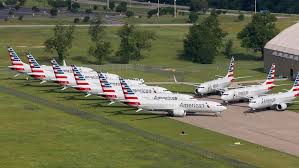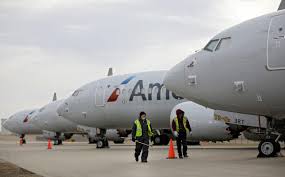
Aviation authorities’ grounding of nearly 400 Boeing 737 Max aircraft has had global ramifications.
But a large part of the story remains local as the Tulsa World found out.
At American Airlines’ Tech Ops-Tulsa, the carrier’s largest maintenance base, workers have for 10 months been babysitting more than $2 billion worth of the 737 Maxes. Two-thirds, or 16, of American’s Max 8s are here; the other eight are at a storage facility in Roswell, New Mexico.
“A lot of the public perception is that these airplanes have kind of been pushed back into the corner and they are just sitting there waiting,” said Erik Olund, American’s managing director of base maintenance. “That’s not accurate.

“… Think of it as maintenance on your vehicle. There are intervals in which we do things. We’re preserving them as if we are flying them every single day.”
Not long after the crash in October 2018 in Indonesia, Boeing began updating software that investigators say was tripped by a faulty sensor and pushed the plane’s nose down. A second Max crashed in March 2019 in Ethiopia, pushing the death total in the planes to 346 and leading to the jet’s grounding.
Boeing said this past week it doesn’t expect federal regulators to approve its changes to the 737 Max until this summer. American Airlines, Southwest Airlines and United Airlines, the three U.S. carriers that own Maxes, have deleted the plane from their schedules until early June.
“From a responsibility aspect, this is unprecedented, the grounding of a fleet like this,” Olund said. “This is really big for us. It says a lot about the character of our people. It says a lot about what we’re doing here in Tulsa that this was the right place to bring these airplanes when we had such a large issue for the company.”
Caring for the Maxes, however, has taxed personnel at the base, which employs about 5,500, he said.
“It’s been a huge manpower draw on us because we have to put a lot of assets around this aircraft,” Olund said. “It’s expensive for us to maintain them but this is the only choice we have. We will not maintain these aircraft to anything less but A-plus standards.”
Once every 10 days, each grounded plane gets the once-over. Fluid levels and tire pressures are checked. Slats are lubricated. Landing gear is serviced.
“It’s a different type of maintenance,” said Steve Harmening, a veteran aviation maintenance technician. “We’re in a storage program now. A lot of it’s prepping airplanes for storage.
“You see a lot of the covers and the foam we put in the engines. It’s not so much of a challenge this time of the year. In the spring, it was harder with the critters and nesting season, birds wanting to get in — and the insects. Closing that all off is something we don’t do standard on our maintenance.”
To shake off inactivity, the jets also are taxied down runways, Olund said.
“It’s a great opportunity for us to simulate a lot of on-the-ground tasks,” he said. “Most importantly, it gets the airplane as if it were in revenue service, so that we get an opportunity to find if anything isn’t passing inspection.”
The eight Maxes in Roswell, New Mexico, will make their way to Tulsa for the same final servicing before returning to the air, Olund said. Once the aircraft is certified, American will run test flights for American team members and invited guests. It expects to gradually phase in the Max for commercial service over the course of a month.
“They are going to be in really good condition to go once they return to flight,” Harmening said. “We are going to have them very presentable. They are going to be clean and everything’s going to be up to specs on them.
“They’re not just parked and sitting in a field. There’s a lot of maintenance going on.”
Source: Tulsa World





